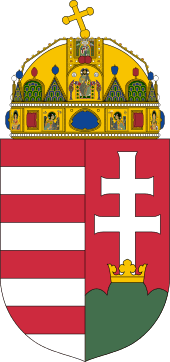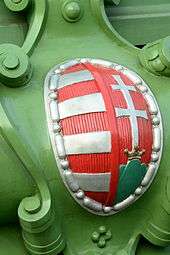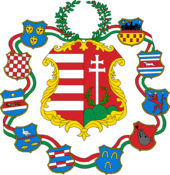Coat of arms of Hungary
| Coat of arms of Hungary Magyarország címere | |
|---|---|
 | |
| Details | |
| Armiger | Hungary |
| Adopted | 3 July 1990 (20th century) |
| Crest | Holy Crown of Hungary |
| Escutcheon | Barry of eight Gules and Argent, impaling Gules, on a trimount Vert a ducal coronet Or issuing therefrom a Patriarchal cross Argent |

The current coat of arms of Hungary was reinstated on July 3, 1990, after the end of communist rule. The arms have been used before, both with and without the Holy Crown of Hungary, sometimes as part of a larger, more complex coat of arms, and its elements date back to the Middle Ages.
The shield is split into two parts:
- The dexter (left side from the viewer's point) features the so-called Árpád stripes, four Argent (silver) and four Gules (red) stripes. Traditionally, the silver stripes represent four rivers: Duna (Danube), Tisza, Dráva, and Száva.[1]
- The sinister (right side from the viewer's point) consists of an Argent (silver) double cross on Gules (red) base, situated inside a small Or (golden) crown, the crown is placed on the middle heap of three Vert (green) hills, representing the mountain ranges (trimount) Tátra, Mátra, and Fátra (made up of the Veľká Fatra and Malá Fatra ranges).[2]
History
Kingdom of Hungary
The most common motifs of the ninth and the early tenth centuries -the griffin, wolf and hind- seldom figure in later Hungarian iconography and heraldic symbolism, however the Hawk or Turul which in shamanistic lore rested upon the tree of life connecting the earth with the netherworld and the skies preserved for longer as a device belonging to the ruling house.[3]
.svg.png) |
The double cross was thought to have been given to Stephen I by the pope as the symbol of the apostolic Kingdom of Hungary. Today, the most accepted theory is that it derives from Byzantine influence, as the cross appeared around 1190 during the reign of Béla III, who was raised in the Byzantine court. The cross appears floating in the coat of arms and on the coins from this era. |
.svg.png) |
The red and white stripes were the symbol of the Árpáds, the dynasty of the first Hungarian kings (1000-1301), and they were first used in the coat of arms in 1202 on one of Emeric's seal. This seal did not include the double cross, only the stripes, and there were nine lions on the white stripes. In the Golden Bull of Andrew II there were only seven lions facing each other. In the middle of the stripes linden leaves were depicted. This coat of arms was used for a short time only; Béla IV used the one with the double cross again. |
.svg.png) |
When the House of Árpád became extinct and the Angevins came into power, they wanted to emphasize their legitimacy and their matrilineal relation to the previous royal house by using the Árpáds' coat of arms, the red and white stripes. They combined this coat of arms with their own, using a coat of arms that resembles the one currently in use, but with the Angevins' fleur-de-lis in place of the cross. |
.svg.png) |
The coat of arms with the stripes on the (bearer's) right and the cross on the hills on the (bearer's) left first appeared on coins during the reign of Vladislaus I (1440-1444) and later on coins of Matthias Corvinus (1458-1490). The crown above the coat of arms also appeared during the reign of Vladislaus I. At first it was only a non-specific diadem but on the 1464 seal of Matthias Corvinus it resembled more the Holy Crown of Hungary. The final version of the coat of arms was set during the reign of Matthias II in the beginning of the 17th century. Its usage became regular during the reign of Maria Theresa. |
.svg.png) |
In the following centuries, the coat of arms of Hungary became more and more complex. It included the coats of arms of the territories which were part of the Lands of the Crown of Saint Stephen: Croatia, Dalmatia, Slavonia,[4] and Bosnia, but the so-called "small coat of arms" always remained the central piece. (The more complex ones were called "medium" and "large coat of arms".) The image to the left shows the medium coat of arms, in official use (with some modifications) from the Austro-Hungarian Compromise of 1867 till the end of World War I (1918). The outer pieces (anti-clockwise from top left) are the coats of arms of Dalmatia, Slavonia, Bosnia (added in 1915), Fiume, Transylvania, and Croatia. When Hungary became part of the Habsburg Empire, the coat of arms became a part of that of the Empire, but later it became of marginal importance and during the reign of Joseph II - who did not even have himself crowned with the Holy Crown - it was omitted from the coins. |
 |
During the Hungarian Revolution of 1848, following the dethroning of the Habsburg dynasty on 14 April 1849, the Holy Crown was removed from the coat of arms. The remaining small coat of arms is usually referred to as the "Kossuth Coat of Arms" (Hungarian: Kossuth-címer) after Lajos Kossuth, Regent-President of Hungary (so unlike the name suggests, it was not the coat of arms of the Kossuth family). In the large coat of arms, however, a laurel wreath replaced the crown both in the central piece and above the shield, as shown on the adjacent image. |
|
After the revolution was repressed, the Hungarian coat of arms was not used again until the Austro-Hungarian Compromise of 1867, when the small coat of arms with the crown once more became a part of a more complex coat of arms, similar to the medium coat of arms shown above. The Hungarian arms also became part of the combined coat of arms of Austria-Hungary. | |
Changes during the 20th Century
.svg.png) |
After World War I, during the time of the First Hungarian Republic a new coat of arms was introduced. The new arms was almost the same as the "small coat of arms" only with the monarchist elements removed to make it look more republican. The Hungarian Republic of Councils in 1919 totally abolished the traditional coat of arms and used the communist five-pointed red star on official documents. After the fall of the communists, the Kossuth coat of arms was used for a short while. |
.svg.png) |
After the restoration of the kingdom, the small coat of arms (with the Holy Crown and the two angels) became official until the First Vienna Award in 1938, when the government started to use the 1915 coat of arms officially again. |
.svg.png) |
During the occupation of Hungary by Nazi Germany in 1944-1945 at the end of World War II, the puppet government formed by the fascist[5] Arrow Cross Party added the letter "H" (for Hungaria) and the Arrow Cross symbol to it. |
.svg.png) |
Following the military forces of Nazi Germany in Hungary being defeated by the Red Army, Soviet military occupation ensued, eventually leading to the creation of a communist government in Hungary. Between 1946 and 1949 the Kossuth-style coat of arms was used, then the Hungarian People's Republic introduced a new state coat of arms in line with socialist heraldry, with a layout closely resembling that of the Soviet Union's. |
.svg.png) |
During the 1956 revolution, the "Kossuth" Coat of Arms was used again. In old newsreels, the Kossuth badge can be seen painted onto the turrets of many revolutionary tanks fighting against the Soviet invasion in the streets of Budapest. Although this revolution was crushed quickly by the Soviet Red Army, the new Communist government did not reinstate the 1949-1956 coat of arms, and thus this coat of arms was used for about a year. |
.svg.png) |
A new coat of arms was created in late 1957. Its usage ended with the adoption of the current coat of arms in 1990. |
 |
Since 1990 the historical crowned small coat of arms has served as the official symbol of Hungary. In the first democratically elected Parliament there was considerable debate about the depiction of the Holy Crown on the coat of arms. The liberal opposition party (Alliance of Free Democrats, SZDSZ) proposed the Kossuth-style "Republican" version but the conservative government backed the historical crowned one.[6] After the majority decision, the restored coat of arms with the crown soon became generally accepted by every political party and there is a national consensus concerning it. |
See also
References
- Bálint Hóman: A magyar címer történetéhez ("Additions to the history of the coat of arms of Hungary"), 1920 (Hungarian)
- Iván Bertényi: Államcímerünk kialakulása ("Emergence of the state coat of arms"), 2003 (Hungarian)
- József Laszlovszky: A magyar címer története ("History of the Hungarian coat of arms"), Egyetemi Nyomda, Budapest, 1989, p. 39
- ↑ Betsy Dru Tecco: How to Draw Hungary's Sights and Symbols, The Rosen Publishing Group, New York, 2005
- ↑ Betsy Dru Tecco: How to Draw Hungary's Sights and Symbols, The Rosen Publishing Group, New York, 2005
- ↑ Martyn C. Rady, Nobility, land and service in medieval Hungary, Palgrave Macmillan, 2000, p.12
- ↑ https://books.google.com/books?id=y0g4YEp7ZrsC&printsec=frontcover&vq=ladis&hl=hu&source=gbs_navlinks_s#v=onepage&q=&f=false
- ↑ "Hungarian Nazis (Arrow Cross Party)". Jewish Virtual Library. Archived from the original on 17 July 2011. Retrieved 4 August 2012.
on October 15th, the Nazis transferred power into the hands of the Arrowcross Party
- ↑ "Koronával vagy anélkül? ("With or without crown?"), Index.hu". Retrieved 19 April 2014.
External links
| Wikimedia Commons has media related to Coats of arms of Hungary. |
- The Hungarian Coat of Arms
- History of the Coat of Arms of Hungary from Szeged University (in Hungarian, with pictures)
- Hungarian Coat of Arms (in French, with pictures)
